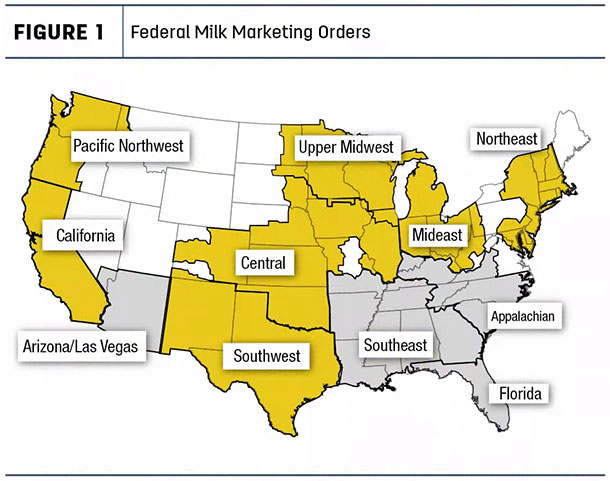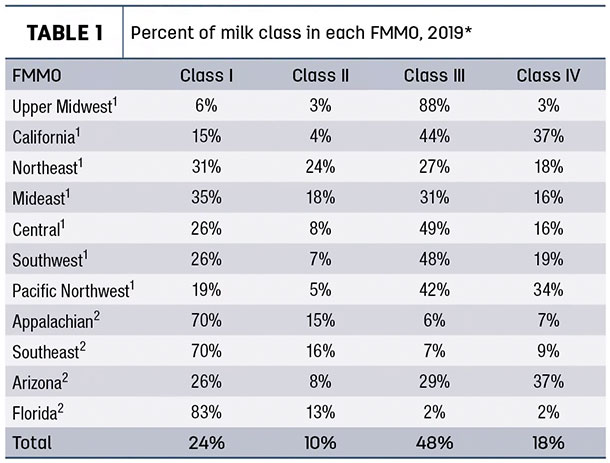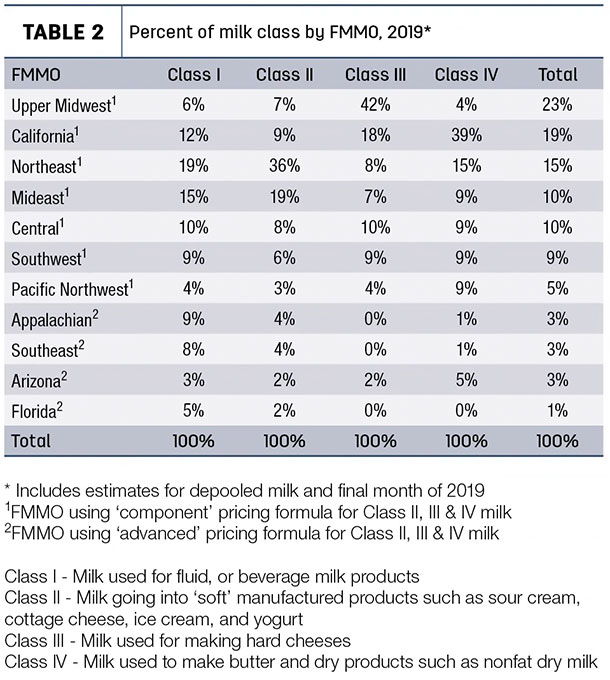In addition, depooling has become a fine-tuned science for managing payments within many of the FMMOs. For reasons explained in this article, increased depooling will likely occur in the future.
FMMO background
First, some background. Figure 1 shows the geographical location of the 11 FMMOs.

The data for an FMMO is based on where the milk is delivered – thus, it is a “marketing” order.
Depending on the class of milk and FMMO, milk payments are determined using “component” or “advanced” pricing formulas. Data for both are collected weekly, and the monthly data is summarized by four- and five-week intervals. Each quarter of reporting during the year contains two four-week months and one five-week month.
The “advanced” pricing formulas use the data from the prior two weeks before the start of the reporting month, and the “component” pricing formulas use the data for the four or five weeks during the reporting month.
For the FMMOs paid by the “component” formulas, the timing difference between the Class I pricing and Class II, III and IV pricing is a complication discussed in detail below.
Class and FMMO differences
The Class I base price for all FMMOs is determined by the “advanced” pricing formulas. All Class I milk must be priced and reported through the FMMOs and must remain in the pricing pool.
For milk Classes II, III and IV prices, the seven FMMOs illustrated in gold (Map 1) use the “component” pricing formulas, while the four FMMOS illustrated in gray are paid using the “advanced” pricing formulas. Approximately 90% of all FMMO milk, including that which is depooled, is paid by the “component” formula.
Unlike Class I milk, Class II, III and IV milk can be depooled by FMMO members – with limitations. This is frequently done when there is a pricing advantage for depooling.
Depooling has become very significant. The Upper Midwest FMMO publishes an estimate of depooled milk, but other FMMOs do not. The depooled milk is still from members of the FMMO and is an important part of the profile of each FMMO. The estimates included in this article include depooled milk and were developed from models and historical trends.
The FMMOs with the most depooling are the Upper Midwest and California.
What is depooling and why is it done?
As noted above, all Class I milk must be pooled, but other classes of milk can be depooled, with limitations. The FMMO system is built around a process to ensure that all milk producers are paid equally. Class I milk for fluid use is typically paid the best. The FMMO pricing process levels the field by averaging the prices of the four classes of milk and effectively using the average as the value for all milk.
In the FMMOs paid by the “component” formulas, every producer is first paid based on the Class III price and, at the end of the month, the four classes are averaged, providing the “uniform” price for each FMMO. The incremental value of the uniform price less the Class III price is known as the producer price differential (PPD). The producer is paid the PPD at the end of the month.
If the price of cheese is rising, the skim Class I price may then be lower than the final “component” priced skim Class III milk, creating a lower “uniform” price and a likely negative PPD. The producer would then owe money to the pool of the four classes of milk.
To avoid this, producers (typically through their cooperative) will elect to depool to avoid “owing” this money. When this happens, Class III milk is depooled and not reported to the FMMO.
Alternatively, when the Class IV price is above the Class III price, some of the Class IV milk may be depooled.
In May of 2019, there was a change in the pricing formula of Class I milk, using an average of skim Class III and skim Class IV plus 74 cents rather than the “higher of” skim Class III or skim Class IV. When there is a large spread between a higher Class III milk price and a lower Class IV milk price, the new formula will lower the Class I price as compared to the prior formulas. That, in turn, reduces the PPD which increases the incentive for depooling. In the latter half of 2019, the Class IV price was significantly lower than the Class III price, and depooling of Class III milk was very significant.
What does all this depooling mean to the producer? The depooled milk is typically paid at the FMMO prices. There is only a consistent amount of money to be split up for pooled and depooled milk. As some producers make more, others make less. The original purpose of pooling was to make sure all producers were paid the same. Depooling changes that.
Tables 1 and 2 show the analytical profiles of the 11 FMMOs in 2019. Table 1 shows the percent of each FMMO’s volume by milk class.

For example, the Upper Midwest has a much higher percentage of Class III milk than any other FMMO. California, the Pacific Northwest and Arizona FMMOs have the largest percent (36%) of their milk going to Class IV to support exports of nonfat dry milk (NDM). The Northeast FMMO has the largest percentage of Class II milk, with much of this going to yogurt production. The Appalachian, Southeast and Florida FMMOs use most of their milk for Class I beverage milk.
Table 2 shows the percent of the class of milk each FMMO produces.

The Upper Midwest provides 41% of total Class III milk. California provides 39% of the Class IV milk; the Northeast provides 36% of the Class II milk and also supplies 19% of all Class I milk.
The data for each FMMO portrays the known trends in domestic dairy consumption. Fluid milk consumption is decreasing, and FMMOs dependent on Class I milk are seeing their needed milk production decrease. Those FMMOs with milk primarily used for cheese production are seeing growth.
The volume of Class III milk for cheese now makes up near half of the total FMMO milk supply. Class I milk for drinking is down to less than one-quarter of the milk supply and falling.
Table 1 also provides a window into the future of each order. Those with large amounts of cheese production using Class III milk will continue to grow. Those with large amounts of fluid milk using Class I milk will shrink in size. As Class I milk continues to fall, the “uniform” price will fall, and more depooling will result.
The downside for the FMMOs with high cheese production is: They do have to deal with the issues of overproduction as excess milk is typically stored in cheese because it has a longer shelf life.
California’s future is more difficult to predict. One of the biggest unknowns is the future of the quota adjustment program, which is being debated. The other uncertainty in California is the future of Class IV NDM. Class IV milk is a big factor in all the West Coast FMMOs. NDM and its cousin skimmed milk powder are primarily export products, with the largest customer being Mexico. International sales can be very volatile as exchange rates, political events, weather and other factors come into play. ![]()

-
John Geuss
- John Geuss Consulting
- Email John Geuss







